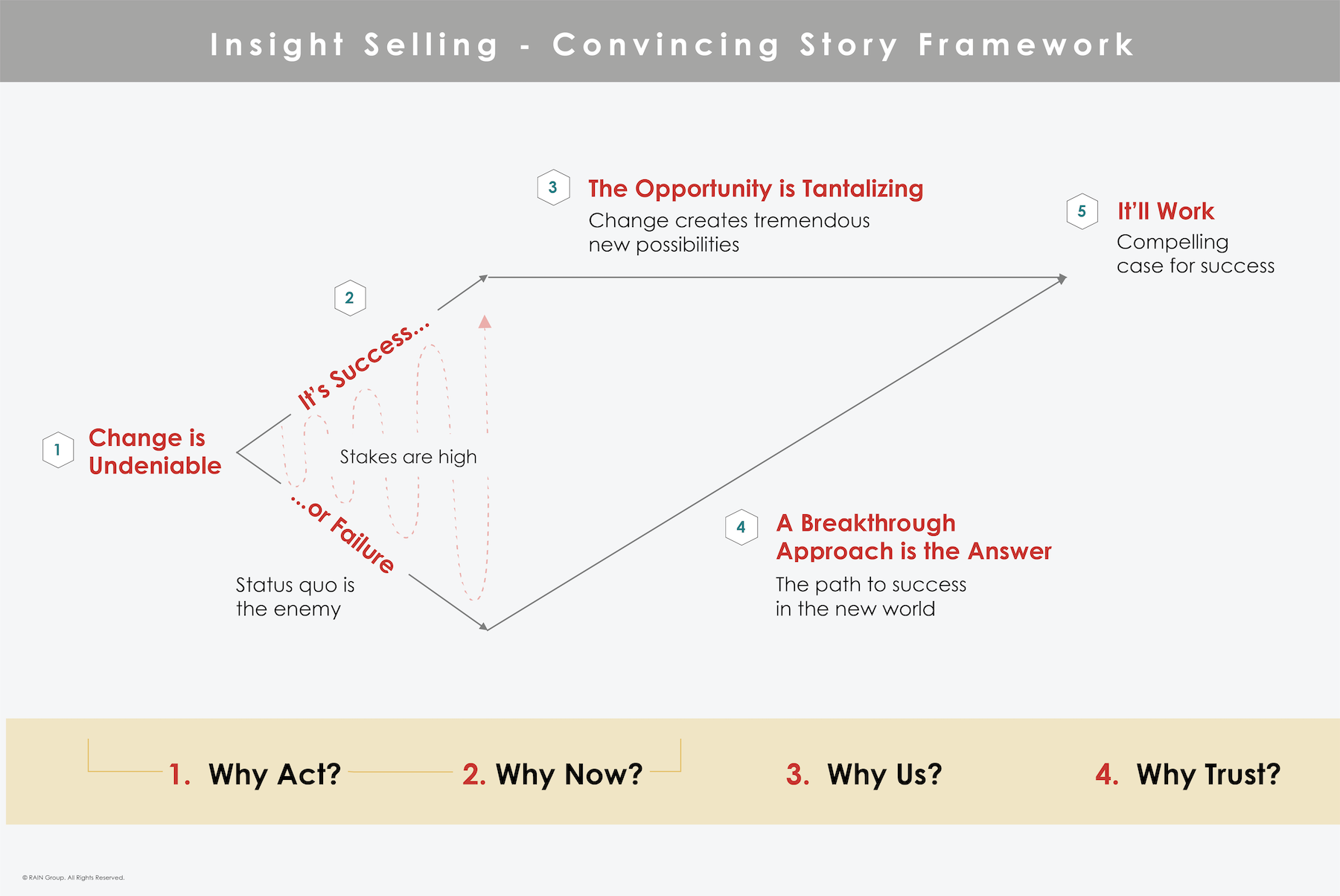CONVINCE
| con•vince |  |
- Cause (someone) to believe firmly in the truth of something.
- Persuade (someone) to take action.
Building confidence in the validity of an idea. Inspiring action.
The sellers who do these best sell the most.
While a few do insight selling naturally, many struggle. Sellers might know with great certainty that when buyers buy they’ll be better off as a result, but they just can’t get the buyers to believe it.
What’s interesting, though, is that the sellers who are good at selling an idea and those who aren’t often both understand the idea and its importance. It’s just that some communicate it far better than others.
Those that do insight selling well—whether they know it or not—satisfy the same basic criteria every time and follow the same story format. The great thing? The basic structure is simple and learnable. We call this basic structure a Convincing Story and we outline it in detail in our new book, Insight Selling: Surprising Research on What Sales Winners Do Differently.
The underlying structure of a Convincing Story looks like this (click here for PDF):
Essentially, every Convincing Story should answer 3 questions:
- What do I want them to learn?
- What do I want them to feel?
- What do I want them to do?
Follow the format, and you’ll get the response you seek.
The 5 Components of a Convincing Story
1. Change is Undeniable
Build rapport and establish credibility by demonstrating keen insight into their world. This can be an overview of influential industry trends, technology that changes the game, or an overview of any context that is relevant to them and gets them saying, "They get it," or, "They get us."
Once you establish yourself as knowing what you’re talking about, you’ll get their attention and build curiosity in hearing the rest of what you have to say. Note, however, that you are not the hero of the story. They are. You establish yourself by establishing your relevance to them.
2. Success vs. Failure
Next, establish the current state and why it’s not good enough. The heart of every action and change—and a key component of insight selling—is the desire to be in a new and different place. By establishing the current state and why it’s not good enough, you give the adversary a name. You put a target on its back.
The adversary can be almost anything: lack of results, slipping market share, wasted time on workarounds, ideas whose time has passed…anything. The masters at insight selling not only tell people what to run towards, but also give people something to run away from.
Your ability to establish and define success—to help them imagine some specific aspiration—is critical. Average sellers focus on establishing the path: “This is what we do and the way we do it.” These are how messages. Nobody cares about the how until they feel the depths of the why.
Getting to the New Reality—the place where they're achieving the results they want—is the why. And why is a powerful force. Simply suggesting, “Here’s where we are and it isn’t good enough,” isn’t, well, good enough. It’s antiseptic. It doesn’t create the intense feeling of desire that’s so important for change, and so critical for insight selling success.
One of the most powerful ways to do this is to describe approaches that haven’t worked and why. By doing this, you can go back and forth between Failure and Success, and you bring the buyer along for the ride. A Convincing Story is an emotional journey, and a bit of a roller coaster. The net effect is that the buyer feels how high the stakes are more powerfully by being reminded that others have been trapped there, tried to get out, and couldn’t. Since everyone relates stories to themselves, they’ll feel trapped as well.
At the same time, you’ll remind them of the possibilities that seem out of their reach. Do this effectively and you’ll build their desire to achieve Success that much more forcefully. By going back and forth between the current state and the new possibilities, you not only establish a very important rational gap (you’re here, but you could be there), but also maximize the negative feelings associated with being in the undesirable place and stoke the desire to achieve a New Reality.
3. Tantalizing Opportunity
Communicate results and create excitement around the new possibilities. Many sellers know how to tell a return on investment (ROI) story, but few do everything they should to communicate the full power of the impact.
You still need to tell the ROI story—and you probably did so in general terms when you established the possible New Reality—but now you must make it real by showing concrete, specific results. The more you can show real results, the greater confidence you’ll build that the buyer can achieve them, too. At the same time, you complete the emotional journey because they imagine themselves having achieved those same things.
Once they do this, they’ll want to be part of the “in” crowd who have achieved success. Their desire for inclusion will intensify. They’ve been to the lows (Success vs. Failure, seeing and feeling the gap), and they feel the highs. As much as some will argue to the contrary, business buyers buy with their hearts and justify with their heads. Selling an idea isn’t just about numbers. Use the Convincing Story structure and you’ll give buyers the justification case for themselves and for others that make them want the results that much more.
4. Breakthrough!–Introduce a New Hope
Just when the buyer feels resigned to a life in the Pit of Despair—where many (like them) are stuck—you show them a different path. A path others have taken to successfully climb out of the pit. A new hope!
When they see what others have achieved when they made a chance, they’ll want to achieve the same. The concept is envy.
But still, making the change a reality is not necessarily a slam dunk. If it were easy, everyone would do it. Since, however, this is what you help people do—and what you have a track record of doing—you can guide them around the many pitfalls that can get in the way. (Remind the young Jedi never to underestimate the dark side.)
This not only establishes you as scarce and differentiated solution, but also as a straight shooter who’s on their side. Do so and they’ll start to believe you and trust you and the solution that much more. Some sellers get this far but miss this step. When that happens, the buyer “sees” the solution and understands the ROI case is compelling, but they still doubt they can achieve it. Sometimes they think they can achieve it without you.
An outcome of insight selling is to help them see that your knowledge, collaboration, and partnership in the journey is essential for their success.
5. It'll Work
Collaborate for action. Most sellers recommend action, specifically a next step. Few, however, build in collaboration. When buyers feel like sellers collaborate with them, they are much more likely to buy, and to buy from that particular seller. At this point, your call to action will be to invite discussion and collaboration.
Many sellers try to move too quickly to make a sale. Jumping from here to a sale is a big leap. By asking only for a commitment to collaborate, you shorten that leap with a stepping stone that moves you closer to the sale, and increases its likelihood of happening.
Collaboration is very powerful and is a core component of insight selling and telling a Convincing Story. Collaboration involves the buyer in the story itself. When people are involved in something, they become invested in its success. The more they become invested in something, the more they take ownership of seeing it through.
Perhaps most powerfully, collaboration creates shared experience. Shared experience leads to intimacy in the “I know you really well” sense. Intimacy is a pillar of trust. And trust is essential when building confidence and selling an idea.
The Power of a Convincing Story
The Convincing Story is valuable as a means of conveying value and building rapport with buyers. As we first covered in Rainmaking Conversations, stories take buyers on an emotional journey.
When listening to a story, people put themselves in the diegesis, the world of the story. Worry, fear, anger, worthlessness, love, acceptance, success, anticipation, validation, regret, victory and freedom are all emotions great storytellers elicit as a matter of course. Not only do people feel these emotions when listening to a story, they see the images in their minds. When connected to powerful emotions, these images stick with them.
In fact, listeners remember stories up to 22 times more often than facts and figures alone.1 The listener's mind "syncs up" with the storyteller's mind in a process called neural coupling.2
Sales isn't just about finding and winning opportunities, it's about driving change: helping buyers get from where they are now to a better place. It would be nice to simply be able to state to someone, "You're here, you should be there," and have them see the light, but that isn't how it happens.
When you tell stories and take buyers on an emotional journey, buyers don't just understand where they want to be, they feel it and see it. If that feeling is different and better than how they feel now, they'll be compelled to do something about it and do it with you.
3 Outcomes of a Convincing Story
There you have it: the elements of a Convincing Story, an essential component to bringing insight selling alive.
Use the Convincing Story structure and you’ll achieve the three outcomes you need to sell an idea: learn, feel, do.
Learn
- Current state is not good enough. It needs to change.
- You “get it” and “get them” because, without even talking with them much and like reading their minds, you’ve described what their world is like.
- Possible New Reality is much more desirable. The stakes are high if you can win this game.
- The rational impact (the ROI) is clear.
- There’s a path to get there, but it requires different thinking and action.
- But do it right and results are achievable.
Feel
- The depth of how undesirable their current state is (e.g., frustrations, problems, and difficulties).
- The full desirability of the possible New Reality and everything that comes with it (e.g., money, success, attention, relief, happiness), even envy of those who have what they don’t.
- Confidence that you, your offering, and your company can help them achieve results.
- Confidence that the result is achievable and, at the same time, worth the risk.
Do
Collaborate with you to bring the New Reality to life.
1. Jerome Bruner, Actual Minds, Possible Worlds - The Jerusalem-Harvard Lectures (Harvard University Press, 1985).
2. Greg J. Stephens, Lauren J. Silbert, and Uri Hasson, "Speaker–listener neural coupling underlies successful communication," (Proceedings of the National Academy of Sciences of the United States of America, 2010), http://www.ncbi.nlm.nih.gov/pmc/articles/PMC2922522/








